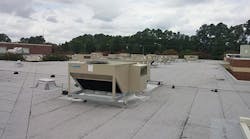At Achilles Elementary School in rural Hayes, Va., one of nine facilities operated by Gloucester County Public Schools, classrooms in the original 1960s-built section of the building were in need of upgrades, including replacement of HVAC equipment.
“In our market, we normally don’t specify rooftops on a job like this, but low clearances between the roof and ceilings necessitated rooftop units to replace exterior wall-mounted unit ventilators,” Matthew Haltiner, LEED AP, senior associate with Hampton, Va.-based Thompson Consulting Engineers, said. “The owner is happy with Daikin equipment in its other schools, and we designed this system for that brand continuity and owner satisfaction.”
Solution
After the engineering and school facility team determined a single-zone rooftop solution was more cost-effective than larger-capacity units with support-weight considerations, the district selected Rebel single-zone variable-air-volume (VAV) units with cooling and heat-pump modes from Daikin Applied.
“The single-zone VAV operation made the installation more appealing and efficient for energy savings, being we could do the single-zone for each of the classrooms,” Haltiner said. “The Rebel units are light and versatile enough to install on a roof with weight concerns. It’s nice these units aren’t terribly heavy and that the job required minimal structural considerations to an existing rooftop that didn’t have any HVAC equipment.”
David Simmons, CEM, energy manager for Gloucester County Public Schools, added: “This has been a time-sensitive project in that we only had approximately eight weeks to do a major renovation. We removed all the unit ventilators and rewired circuits to ensure the new rooftop units meet current standards.”
The design of the new HVAC system allowed other mechanical and safety equipment to remain located in the tight ceiling spaces, although some ductwork redesign was required.
“Our main challenge was dealing with existing conditions of the tight ceiling spaces that contained piping, electrical, and communications lines,” Christopher Brown, vice president of Camden, N.C.-based CB Plumbing & Mechanical Inc., the installing mechanical contractor, said. “For example, ductwork had to be made wider and thinner in certain areas, and we connected ductwork to ceiling-mounted supply and return grills in some cases.”
With a quiet inverter-driven variable-speed compressor and modulating hot-gas reheat, the rooftop units deliver the preferred air temperature, avoiding overcooling or overheating and allowing the school to minimize use of its propane fuel supply.
“This allows the school to use Rebel’s heat-pump mode for energy-efficient heating until it’s too cold outside for heat-pump operation, and then the Rebel units switch over to propane gas,” Greg Prose, Daikin Applied representative and sales engineer with Hoffman & Hoffman Inc. in Chesapeake, Va., said.
“The Rebels are the only rooftop units in the district that can do this, and, additionally, it’s an energy-saving feature,” Prose continued. “The units also have a zero-to-100-percent economizer for economizer operation when possible.”
For additional energy savings and to ensure optimum indoor-air quality, a self-cleaning, no-maintenance air-purification system that uses bipolar ionization technology was installed on each Rebel rooftop.
“We installed the bipolar ionization to reduce the outside air to the space, which reduces the total capacity from the system,” Haltiner explained, noting a formula of 0.06 cfm per square foot plus 10 cfm per student was specified to meet or exceed the ASHRAE standard. “It removes the need for an energy wheel and the exhaust fan associated with it.
“We are still required to have the same size compressor, but it doesn’t have to do as much work as when incorporating an energy wheel, so the customer receives the benefit of the reduced total capacity of the system, but not the total cooling capacity of the compressor,” Haltiner added.
Outcome
The Rebel units serve about 22,000 sq ft of space, including 12 classrooms, two hallways, and two computer laboratories. Startup was completed in mid-August 2015 by the Daikin Service Group after some adjustment of the flashing on the rooftop curbs. The units were commissioned by a third-party provider.
“The new Rebels are all on the roof with sound-isolation foundations so you don’t hear them in the classroom, unlike the loud motors of the unit ventilators that were in the classroom,” Simmons said. “This will be a much better learning environment for the kids.”
Sensors in the rooftop units communicate with the school’s centralized building automation system (BAS).
“Our rooftops don’t have local control, though they have temperature readouts in each classroom,” Simmons said. “We control the system through our BAS, which cuts down complaints about occupant comfort, and each classroom can be controlled individually.”
Simmons concluded the Rebel units are “easy to work with and user-friendly.” Of the Daikin Service Group that started up the system and is working with the controls integrator, he said: “The technicians ... have been outstanding and right on the money. We receive very helpful, responsive service from the Richmond office.”
For Design Solutions author guidelines, call Scott Arnold, executive editor, at 216-931-9980, or write to him at [email protected].










